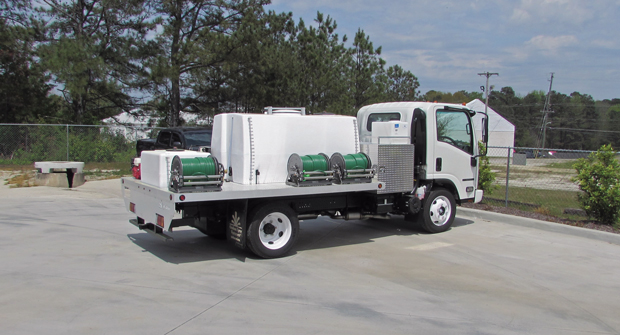For lawn care operators (LCOs), proper organization is an essential element for completing any job.
“If your trucks are organized, even if it comes down to your tools and putting them right back in their same spot, it makes things easier for workers to find stuff, get things fixed and be quicker on a site,” says Jennifer Wing, marketing manager for Hannay Reels. “If things are unorganized and you’re spending time looking for things, you’re wasting time and money. Organization leads to efficiency, which leads to the cost-effectiveness of a truck build or layout.”
When Dave Arnett, sales manager for Graham Spray Equipment, talks to contractors about organizing their trucks, he often finds himself asking, ‘What do you think you need to go out there and maximize your daily revenue potential?’
“Our rigs are set up one way by their specifications, whereas multiple tanks and systems can spray turf and trees and shrubs,” Arnett says. “We can also offer accessories like backpack brackets and storage boxes for dry fertilizer.”
According to Wing, proper organization is about knowing what you need, what things will come up during the day and trying to make the most of the space on the truck.
“It’s very easy to roll up a hose and throw it in the truck and go, but when planning a truck layout, a hose or cable reel can save time and protect that piece of equipment,” Wing says. “It can be expensive, but sometimes, cables can be more expensive than the reel itself. It’s a safety issue a lot of the time.”
In addition to a reel, contractors should be sure to include tanks for chemicals, mounts for equipment, hoses and safety tools on their spray trucks.
Successful truck organization starts with the truck itself. Brian Tabel, vice president of Isuzu, says safety is the company’s No. 1 priority with its offerings to LCOs. When discussing the chassis and new diesel truck from Isuzu, he says that new configurations have made things easier for drivers while operating the vehicle.
“The first generation of our truck came out in 2007 and a lot of changes have gone into making it more ergonomically user-friendly for the driver,” Tabel says. “There are different pockets, a rear passenger pocket to slide paperwork into, a new work surface, a center seat, different hooks and positioning of buttons.”
As the times have changed, driving has become simpler, he adds. This means that Isuzu’s trucks have new features like steering controls, which limit the time a driver has to make adjustments while driving.
While a contractor considers these options and accessories, knowing their budget is an important factor.
“Expenses are at an all-time high for almost everything now, so I think contractors need to look at their overall initial expenses on a truck and the longevity of the product they’re putting on it,” Wing says. “You can get an aftermarket part fairly inexpensive, but will it last? Will you have to replace it in a year? Then you’re paying twice. So, paying a little more for a product that lasts will save you money in the long run.


